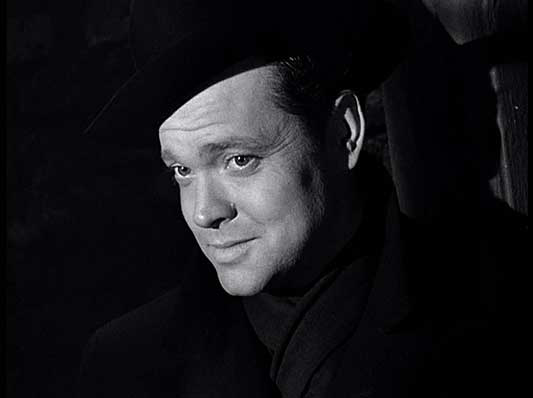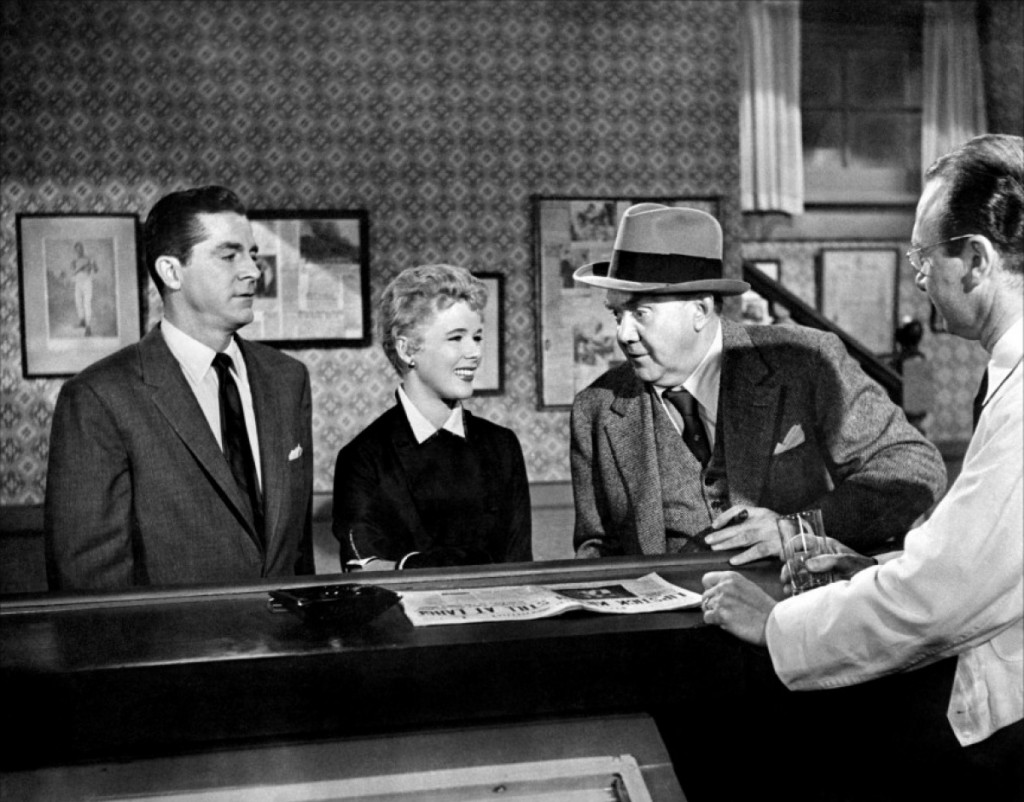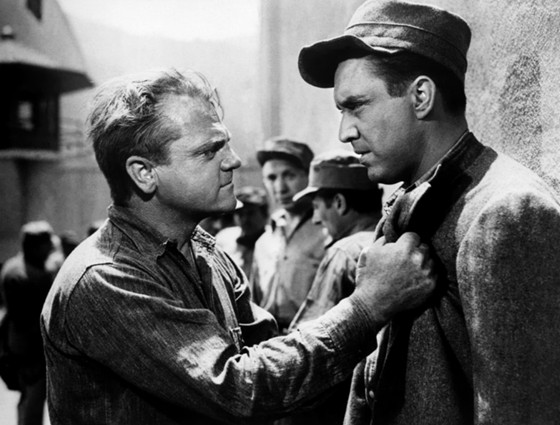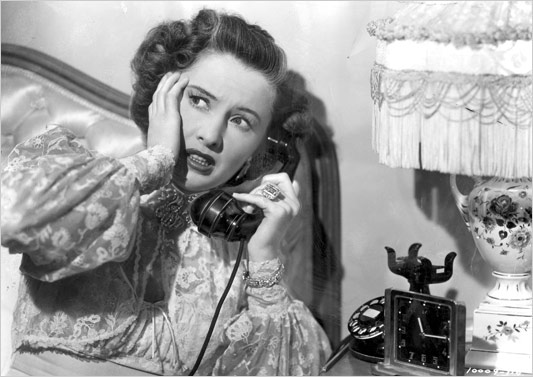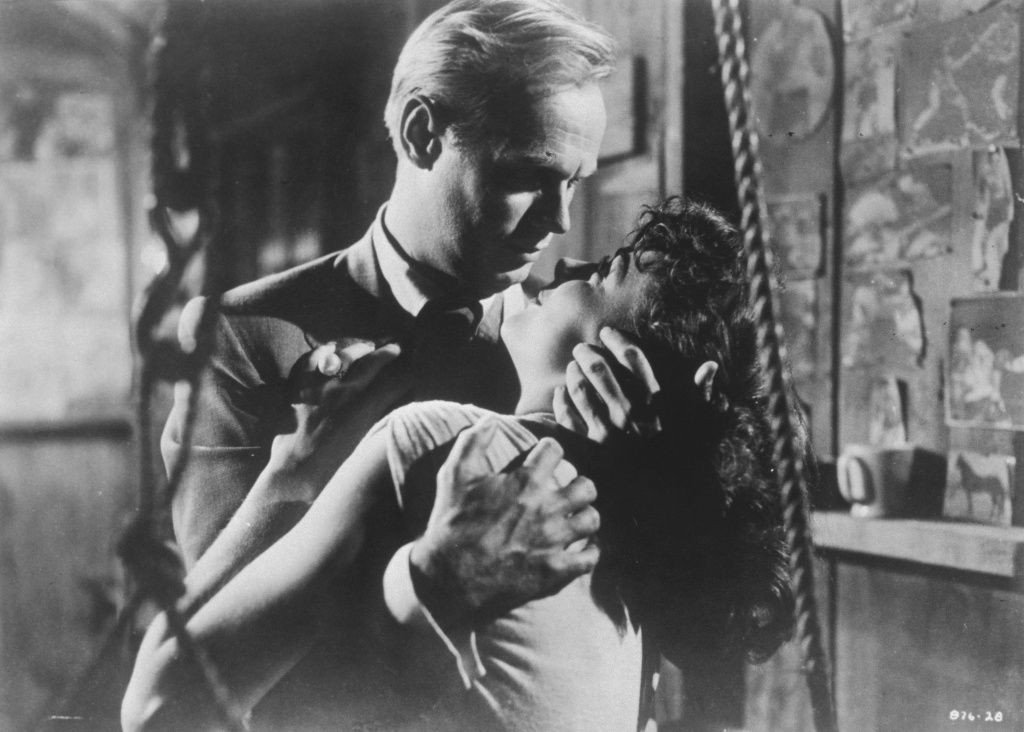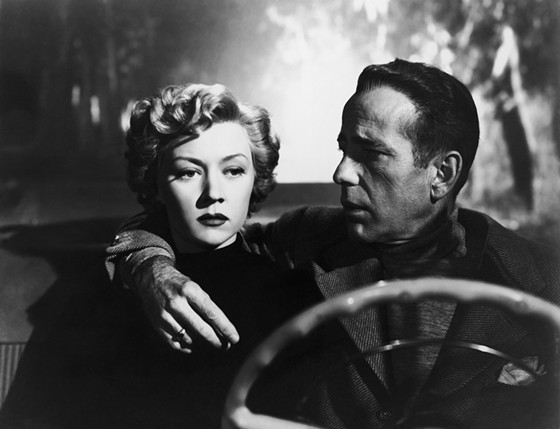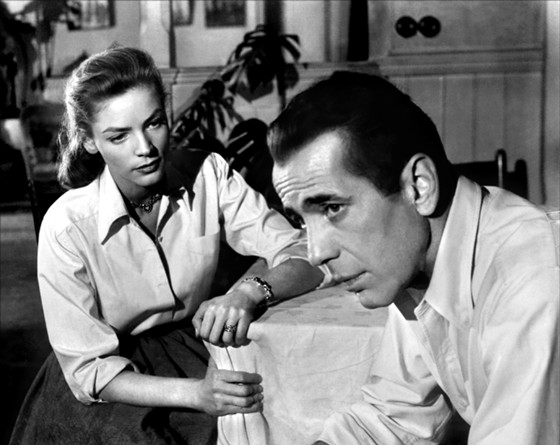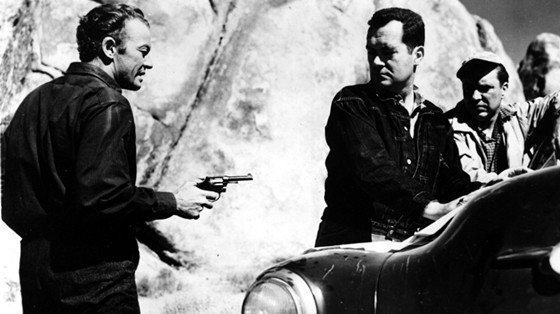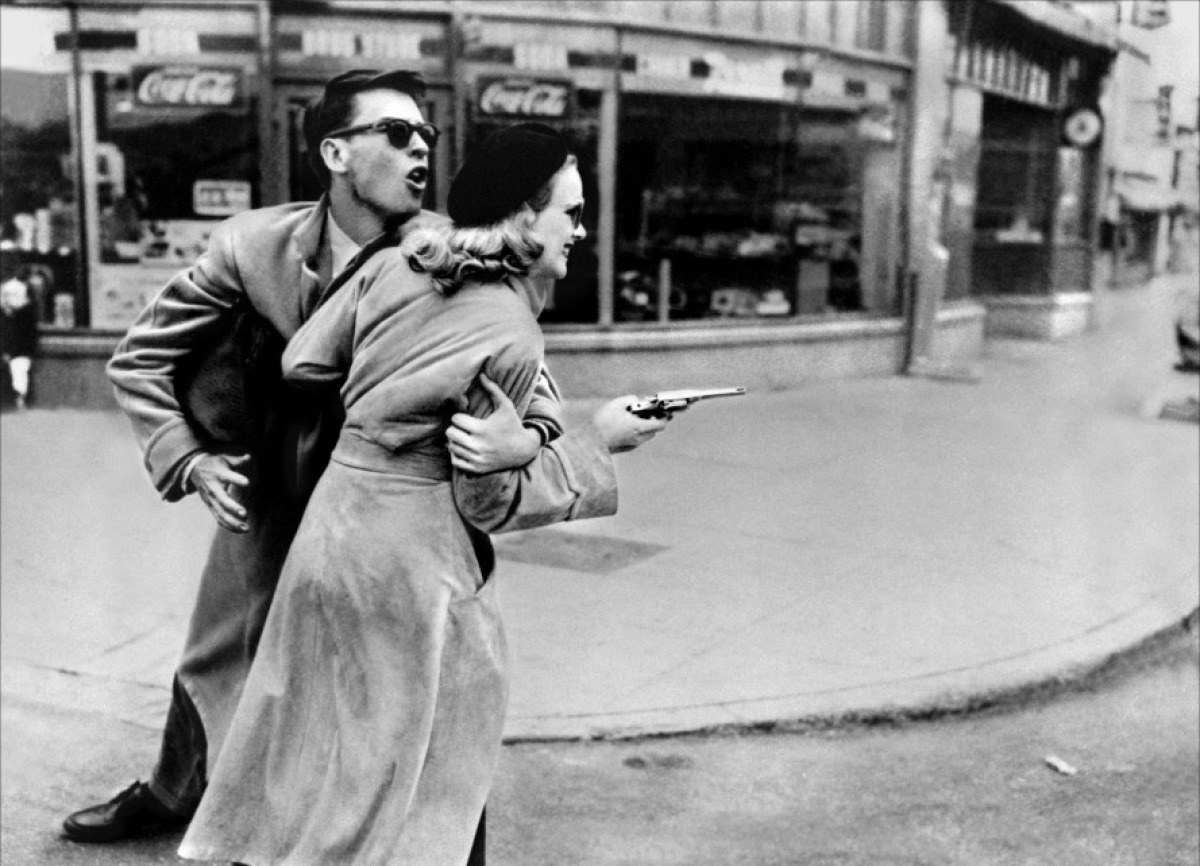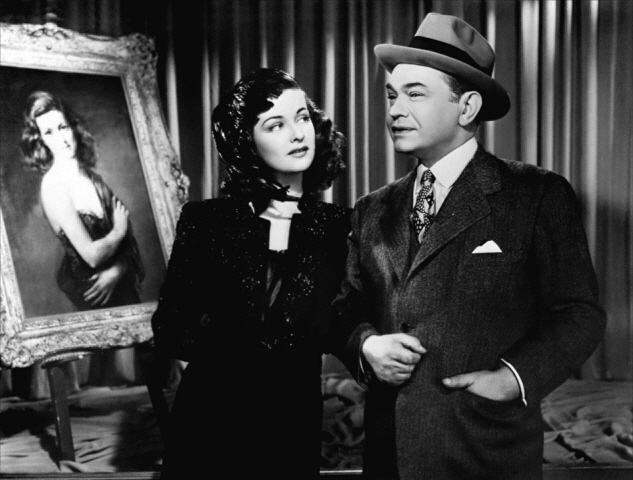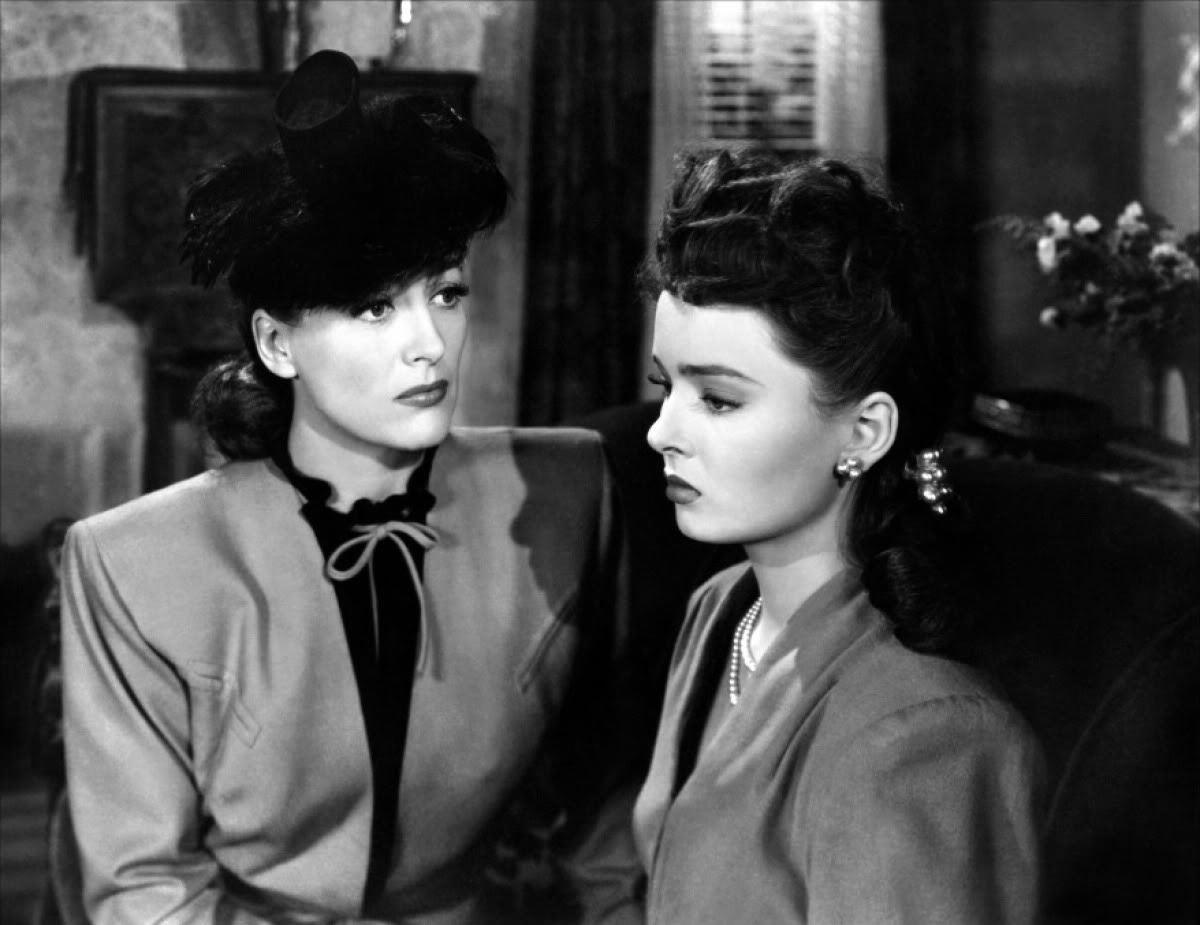Film noir was a genre (or, some prefer, a cycle of films) that thrived predominantly in Hollywood crime films in the early post World War II years, as men were returning from the military to their lives at home, and these films express the anxiety that many men felt about being displaced as workers, boyfriends, husbands and fathers during wartime. This anxiety is expressed in film noir as a sense of disorientation, confusion and distrust, as well as a sense of entrapment in a nightmare world that has gone out of control.
The protagonists of these film are men who are often in love with and yet betrayed by beautiful women and they often face the choice between a fair haired ‘good’ woman and a dark haired, sultry ‘femme fatale’ who is likely to lead them astray down the wrong path (which is the path that they take, for the most part). Most of the early film noir from the 1940’s are told in flashback with voice over and are shot with many night scenes featuring high contrast lighting, dark shadows and odd camera angles.
By the 1950’s, ‘hard boiled’ detectives like Sam Spade and Phillip Marlowe were replaced by more unpredictable, violent figures like Mickey Spillane’s Mike Hammer and the stories became more widely varied in terms of theme and location, reflecting looser codes and conventions.
By the late 1950’s the cycle had come to an end, and most films after that time are considered ‘neo-noir’ films, as opposed to full blown legitimate Film Noir. Here are the 30 essential Film Noir from the original period that you need to watch.
30. While the City Sleeps (1956)
A serial killer dubbed “the Lipstick Killer” is on the loose in New York attacking women, and when media mogul Amos Kyne dies, his son Walter (Vincent Price) initiates a battle between the various department heads to see who can solve the mystery and break the story first.
In the midst of it all is reporter Walter Mobley, played by noir veteran Dana Andrews, who allies himself with newspaper man John Day Griffith (Thomas Mitchell) against wire-service chief Mark Loving (played by always despicable George Sanders). Mobley struggles to catch the killer while dealing with his own personal problems and the tumult at work.
A late entry from director Fritz Lang, While the City Sleeps was interesting for its depiction of the behind the scenes goings on of the media world in an era when newspapers and print reporting was still tops.
29. White Heat (1949)
White Heat is part film noir, part gangster film, with James Cagney as criminal ringleader Cody Jarrett. Married to the deceitful Verna (Virginia Mayo) but totally devoted to his mother, “Ma” (Margaret Wycherly) Cody and his gang rob a mail train but the job goes awry. Cody confesses to a lesser crime in order to get a shorter prison stretch; in prison he is befriended by Hank Fallon (Edmund O’Brien) an undercover agent trying to find out who is laundering Cody’s money.
On his release from prison, Hank comes along with Cody as he must deal with his right-hand man Ed Somers who is trying to take over his gang, and his wife. White Heat has two memorable scenes, one in the prison dining hall when Cody freaks out after hearing the news that his mother has died and the second the film’s finale, a big shoot out at a chemical plant.
Surrounded by police atop one of the chemical tankers, Cody goes insane screaming “Top of the world, Ma!” as he blows himself up. White Heat is not a prototypical noir film of the time, but more of a gritty gangster film with noir elements. Directed by Raoul Walsh, the film features memorable performances by Cagney and noir regular Edmund O’Brien.
28. Sorry, Wrong Number (1948)
Because it came shortly after the classic period of radio, many early film noir were based on radio dramas from the 1930’s and early 40’s, and Sorry, Wrong Number is perhaps the best known. The radio play starred Agnes Moorehead as the bedridden Leona Stevenson, but in the film the role was taken by frequent noir actress Barbara Stanwyck.
Leona has overheard a phone call in which a woman’s murder is plotted for 11:15 that night; as she makes a series of calls, she gradually pieces the story together (through flashbacks, in the best noir tradition) that leads her to believe that he her husband, Henry, has set her up for the murder and that she is the woman who was being discussed in the call she overheard.
The film gives the backstory of Henry and Leona’s life. She is the daughter of wealthy owner of a chain of drugstores J.B. Cotterell (Ed Begley, Sr.), and Leona marries the poor Henry despite her father’s objections. Leona and her father keep Henry employed at Cotterell’s, but give him a meaningless job, and Henry eventually becomes involved in a scheme to steal drugs from Cotterells via a chemist named Wally Evans and sell them to the crooked Morano (frequent noir heavy William Conrad).
Henry eventually gets in debt to Morano and has to sell out his wife – who has become bedridden due to her psychosomatic belief that she has a heart condition – to the crooks. Stanwyck ratchets up the tension of the film as her performance becomes increasingly shrill and manic, as she gradually realizes that she is the target of the murder threat.
Though a bit melodramatic, the concluding scene is a masterpiece of noir drama. Sorry Wrong Number was made at Paramount, one of Hollywood’s most European influenced studios and was directed by Ukrainian Anatole Litvak with music by Franz Waxman, a frequent contributor to film noir.
27. Pickup on South Street (1953)
Directed by tough guy directer Samuel Fuller, Pickup on South Street stars noir regular Richard Widmark as Skip McCoy, a pick-pocket who happens to steal the wallet of Candy (Jean Peters). Candy was doing a final favor for ex-boyfriend Joey who, unbeknownst to her is a communist spy, and in Candy’s wallet is a bit of microfilm containing stolen government secrets.
Skip and Candy now become involved in a struggle with various government agents and mobsters, all after the microfilm, and finally have to learn to trust each other to survive in a world where the double cross rules.
An unusual story produced at the height of the McCarthy era, Pickup on South Street is a brutal and violent film that barely skirted the production code with its depictions of beatings and life in the mean streets. Made at Twentieth Century Fox, Marilyn Monroe was considered for the role of Candy, but director Fuller eventually gave the part to Peters.
26. In a Lonely Place (1950)
The difference between 1940’s and 1950’s film noir is never more evident than in In a Lonely Place, starring Humphrey Bogart as ‘Dix’ Steele, a down on his luck screenwriter. No longer playing the heroic detective, Bogart’s character is highly problematic. He has an explosive temper and after giving Mildred, a night club hat check girl, a ride home one night, is suspected of murdering her after she is killed later that night.
Mildred’s neighbor, Laurel Gray (Gloria Graham) is called on to give testimony about seeing Dix at the apartment that night, and she enters into a tempestuous relationship with Dix while the murder investigation goes on.
In a Lonely Place was directed by Nicholas Ray, who would go on to direct James Dean in his definitive performance in Rebel Without a Cause. The complex characters and conflicting motivations make In a Lonely Place an unusual film noir, and give an indication of how the genre was expanding to take in a wider range of styles.
25. Key Largo (1948)
Humphrey Bogart, one of the definitive noir actors, and wife Lauren Bacall were teamed up again with a veteran of 1930’s gangster films, Edward G. Robinson. Bogart is Frank McLoud, recent combat veteran who stops in at the Key Largo hotel of James Temple (Lionel Barrymore) and his daughter-in-law Nora (Bacall), widow of an army friend of Frank’s.
Staying at the hotel is Johnny Rocco (Robinson), a gangster exiled to Cuba for the past few years, who is holed up with his gang waiting to make contact with some criminal associates. Rocco holds the Temples and McCloud as virtual prisoners in the hotel after killing a police officer during a violent hurricane, at one point humiliating Frank as well as his alcoholic former girlfriend, Gaye Dawn (Clair Trevor).
With the law closing in, Rocco forces Frank to pilot a boat to take Rocco and his gang back to Cuba. Frank ends up taking out Rocco’s hoods one by one until it is just Rocco and himself, then kills the gangster in a final, climactic shootout, before piloting the boat back to Key Largo and the Temples.
A meditation on heroes and heroism, Key Largo is a gritty film that, like many of director John Huston’s best works, shows people at their worst and best during times of extreme stress and difficult circumstances. Although Key Largo has a sense of optimism at the end that is unusual for a film noir, it has the bleak tone and problematic characters that are typical of the genre. This was the fourth and final film of Bogart and Bacall, including Dark Passage (1947), another outstanding film noir.
24. The Hitchhiker (1953)
For years, film directing was a totally male dominated profession, and The Hitchhiker is rare in that it was directed by a woman, actress Ida Lupino. Noir regular Edmund O’Brien and Frank Lovejoy play Roy and Gilbert, two friends on a fishing trip in the desert southwest.
The two men pick up a hitchhiker who turns out to be the psychotic killer Emmett Myers (William Talman). Myers forces the two men to take him to Mexico in order to escape the police. The harrowing journey finally ends in a border town where Myers tries to take a ferry out of the country.
The film is gritty and suspenseful, and director Lupino substitutes the usual noir urban environment for the arid desert, as the two men try to survive their brutal ordeal at the hands of the killer. The film was based on a real incident that had occurred several years earlier, and it has a realistic sense that adds to the drama. After one more film, Lupino turned to directing TV shows, although she did have a final outing in 1966 with the definitely non noir The Trouble with Angels.
23. Gun Crazy (1950)
A precursor to Bonnie and Clyde, Gun Crazy is the story of Bart Tare (John Dall) a troubled young man who is good with a gun who meets sharpshooter Annie Laurie Starr (Peggy Cummins) when they work together at a carnival. Fired from the carnival by a jealous boss, Bart and Annie get married and try to live the straight life, but find themselves drawn to a life of crime.
The two eventually go on a crime spree of legendary proportions. On the run and tracked by the FBI, the two lovers find themselves hopelessly trapped and eventually doomed, but not before plenty of violence occurs.
Gun Crazy developed something of a cult following in the 70’s and 80’s. It was directed by low budget director Joseph H. Lewis, who also built a cult following and directed several other interesting noir films, including My Name is Julia Ross and The Big Combo.
22. The Woman in the Window (1944)
Many characters in film noir based their actions on deeply seeded psychological motivations, and nowhere is this more evident than in The Woman in the Window, directed by German emigre Fritz Lang, who made a number of classic films in Germany (such as Metropolis and M) before fleeing Hitler. Edward G. Robinson plays a criminology professor, Richard Wanley who, after he sends his wife and children away for vacation, meets friends at a club for dinner.
On entering the club, Wanley has seen a portrait of a beautiful woman, Alice Reed, in the window of a nearby building and after his dinner he happens to meet Reed on the street and goes back to her apartment. Into Reed’s apartment bursts her rich and jealous lover, Claude Mazard and after a brief struggle with Wanley, Mazard is killed.
Reed and Wanley bury the body in the country but leave a number of incriminating clues, some of which come to light when Wanley is called in to consult on the crime by his D.A. friend Frank Lalor (Raymond Massey). The situation becomes even worse for Wanley when Reed begins to be blackmailed by crooked ex-cop Heidt (Dan Duryea, a frequent noir bad buy and character actor). Can Wanley escape from the trap that his fascination with the beautiful Alice has ensnared him?
See The Woman in the Window and its twin brother Scarlet Street (released a year later, also directed by Lang, starring Robinson, Bennett and Duryea) to find out. With its emphasis on Freudian psychological explanations for criminal behavior, The Woman in the Window was a ground breaker and certainly is one of the most interesting films from the classic noir period.
21. Mildred Pierce (1945)
Warner Brothers, with its emphasis on crime and social problem films, was one of the earliest and most successful studios to make noir films. When Joan Crawford left MGM and came to Warners, this was her initial outing as star (Bette Davis famously turned down the part before her) and it was an enormous success.
The film seems to function in two worlds, the melodramatic daytime world of Mildred’s successful restaurant chain that is filmed in low contrast ‘high-key’ lighting, and the noir nighttime world of Mildred’s outside life with daughter Veda (Ann Blyth) and her chiseling second husband, Monte Beragon (Zachary Scott) that is filmed in the shadowy, high contrast, chiaroscuro lighting style typical of film noir.
When hard working Mildred (Crawford) divorces her first husband Bert Pierce (Bruce Bennett), she is determined to make a success of herself for her daughter Veda, who seems to want all the best things in life. The restaurant that Mildred starts is a money maker and, with the help of business manager Wally Fay (Jack Carson) Mildred opens a chain of eateries and can give Veda all she wants, until into their life comes Beragon, a formerly wealthy playboy who married Mildred.
Veda eventually despises the plebeian way her mother makes a living and seems to be in love with Monte, who – in the opening scene of the film – is shot to death at Mildred’s beachfront home. Like many film noir, the entire movie is told in flashback until, at the end, the killer is revealed.
A tour de force performance by Crawford brought her a well deserved Academy Award (while Bette fumed) for best actress, and her career was resurrected for over a decade at Warner’s, where she made such later films such as Humoresque, and in 1954 she made the camp western Johnny Guitar that some view as the only western film noir.
